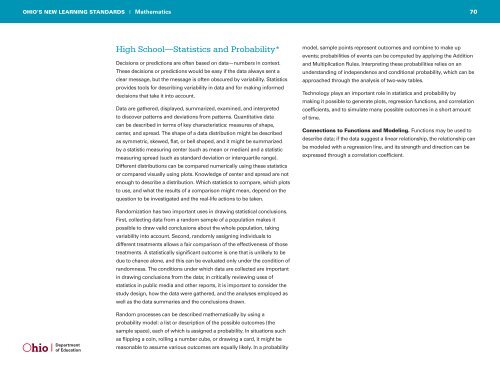Math-Standards.pdf
Math-Standards.pdf
Math-Standards.pdf
Create successful ePaper yourself
Turn your PDF publications into a flip-book with our unique Google optimized e-Paper software.
OHIO’S NEW LEARNING STANDARDS I <strong>Math</strong>ematics 70<br />
High School—Statistics and Probability*<br />
Decisions or predictions are often based on data—numbers in context.<br />
These decisions or predictions would be easy if the data always sent a<br />
clear message, but the message is often obscured by variability. Statistics<br />
provides tools for describing variability in data and for making informed<br />
decisions that take it into account.<br />
Data are gathered, displayed, summarized, examined, and interpreted<br />
to discover patterns and deviations from patterns. Quantitative data<br />
can be described in terms of key characteristics: measures of shape,<br />
center, and spread. The shape of a data distribution might be described<br />
as symmetric, skewed, flat, or bell shaped, and it might be summarized<br />
by a statistic measuring center (such as mean or median) and a statistic<br />
measuring spread (such as standard deviation or interquartile range).<br />
Different distributions can be compared numerically using these statistics<br />
or compared visually using plots. Knowledge of center and spread are not<br />
enough to describe a distribution. Which statistics to compare, which plots<br />
to use, and what the results of a comparison might mean, depend on the<br />
question to be investigated and the real-life actions to be taken.<br />
model, sample points represent outcomes and combine to make up<br />
events; probabilities of events can be computed by applying the Addition<br />
and Multiplication Rules. Interpreting these probabilities relies on an<br />
understanding of independence and conditional probability, which can be<br />
approached through the analysis of two-way tables.<br />
Technology plays an important role in statistics and probability by<br />
making it possible to generate plots, regression functions, and correlation<br />
coefficients, and to simulate many possible outcomes in a short amount<br />
of time.<br />
Connections to Functions and Modeling. Functions may be used to<br />
describe data; if the data suggest a linear relationship, the relationship can<br />
be modeled with a regression line, and its strength and direction can be<br />
expressed through a correlation coefficient.<br />
Randomization has two important uses in drawing statistical conclusions.<br />
First, collecting data from a random sample of a population makes it<br />
possible to draw valid conclusions about the whole population, taking<br />
variability into account. Second, randomly assigning individuals to<br />
different treatments allows a fair comparison of the effectiveness of those<br />
treatments. A statistically significant outcome is one that is unlikely to be<br />
due to chance alone, and this can be evaluated only under the condition of<br />
randomness. The conditions under which data are collected are important<br />
in drawing conclusions from the data; in critically reviewing uses of<br />
statistics in public media and other reports, it is important to consider the<br />
study design, how the data were gathered, and the analyses employed as<br />
well as the data summaries and the conclusions drawn.<br />
Random processes can be described mathematically by using a<br />
probability model: a list or description of the possible outcomes (the<br />
sample space), each of which is assigned a probability. In situations such<br />
as flipping a coin, rolling a number cube, or drawing a card, it might be<br />
reasonable to assume various outcomes are equally likely. In a probability


